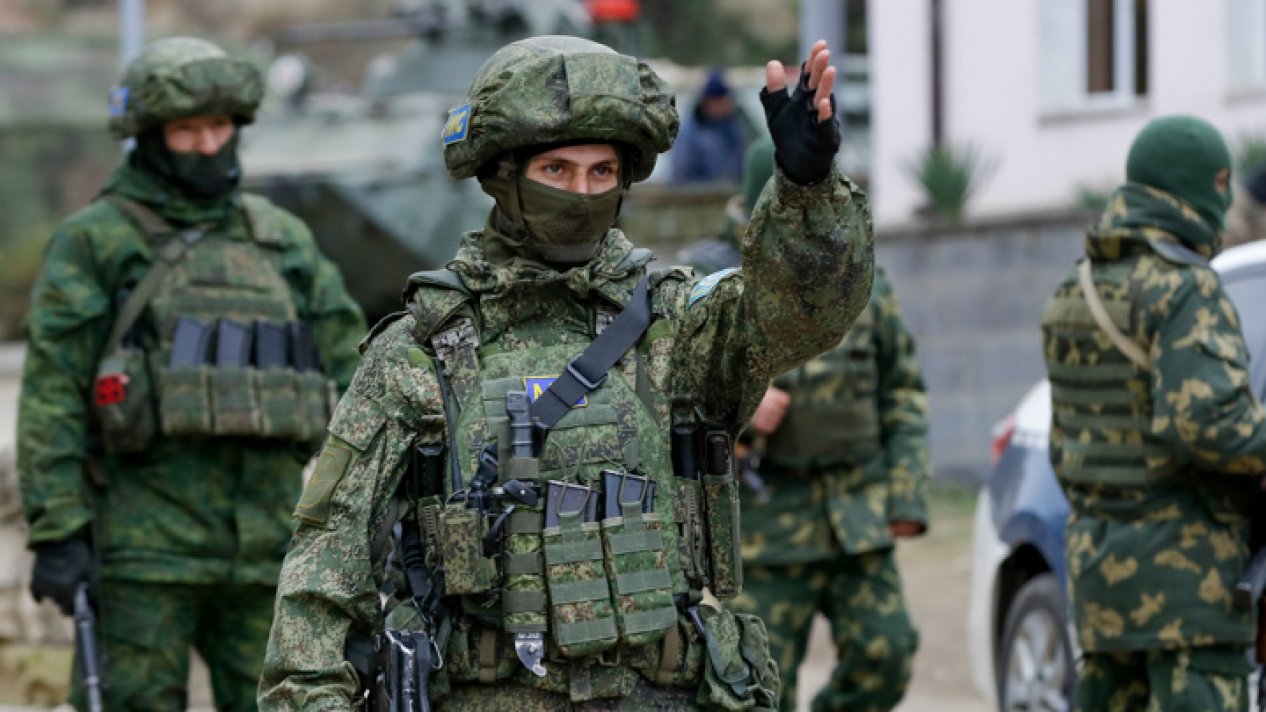
A provocative text has appeared on the official website of the Russian Defense Ministry.
In particular, it says that “from March 24 to March 25, the Azerbaijani armed forces, violating the provisions of the trilateral statement of the leaders of Russia, Azerbaijan and Armenia dated November 9, 2020, entered the zone of responsibility of the Russian peacekeeping contingent in the territory of Nagorno-Karabakh and set up an observation post.”
“Four strikes were inflicted by a Bayraktar-TB 2 type drone on units of the armed formations of Nagorno-Karabakh in the area of the FURUKH (Parukh) settlement. Currently, the command of the Russian peacekeeping contingent is taking measures to resolve the situation and return the troops to their original position. The Azerbaijani side was urged to withdraw their troops,” the Russian Defense Ministry said in a statement.
This frankly provocative statement by the Russian defense ministry did not go unanswered.
The Azerbaijani Defense Ministry expressed its regret in connection with the one-sided statement of the Ministry of Defense of the Russian Federation dated March 26, 2022.
“The Ministry of Defense of the Republic of Azerbaijan expresses regret regarding the one-sided statement of the Ministry of Defense of the Russian Federation dated March 26, 2022, which does not reflect the reality.
On March 25, during the telephone conversation between Azerbaijan Defense Minister Colonel General Zakir Hasanov and Russian Defense Minister Sergei Shoigu, the situation in the territory of Azerbaijan, where the Russian peacekeeping forces are temporarily stationed, was discussed. The Azerbaijani side stated that the positions and deployment locations are being clarified on spot.
However, in the morning of March 26, members of illegal Armenian armed detachments attempted to sabotage the Azerbaijan Army Units. As a result of immediate measures, members of illegal Armenian armed detachments were forced to retreat.
The Defense Ministry states that Azerbaijan is committed to the Joint Statement of November 10, 2020 and has not violated any of the provisions.
We regrettably inform that the withdrawal of the remnants of the Armenian army and illegal Armenian armed detachments from the territory of Azerbaijan in accordance with article 4 of this Statement has not yet been completed. Therefore, it is Armenia, not Azerbaijan, that violates the provisions of the Statement.
The Ministry of Defense states that the statement of the Ministry of Defense of the Russian Federation contradicts the essence of bilateral relations and the Declaration on Allied Interaction signed between the two countries on February 22, 2022.
There is no administrative and territorial unit called "Nagorno-Karabakh" in the territory of Azerbaijan. The name of the village mentioned in the statement is not Furukh, but Farrukh.
Regarding this, the Ministry of Defense of the Republic of Azerbaijan requests the Ministry of Defense of the Russian Federation to completely withdraw the remnants of the Armenian army and illegal Armenian armed detachments from the territory of Azerbaijan recognized by the international community in accordance with the provisions of the Joint Statement, asks not to use the term "Nagorno-Karabakh" and correctly indicate the names of the territories of Azerbaijan,” the Azerbaijani Defense Ministry said in a statement.
Faktyoxla Lab. has tried to deal with some of the details of the statement of the Russian Ministry of Defense, which certainly raises serious questions.
First of all, a legitimate question arises, why does the Russian Defense Ministry characterize the Armenian militants located in their zone of responsibility on the territory of Azerbaijan as "divisions of the armed formations of Nagorno-Karabakh"? But the main thing is why are armed people, regardless of their status, generally located on the sovereign territory of Azerbaijan, temporarily under the control of the Russian peacekeeping contingent?
This question is surprising, since the withdrawal of all Armenian armed forces is a prerequisite for the tripartite statement on Karabakh by the President of the Republic of Azerbaijan, the Prime Minister of the Republic of Armenia and the President of the Russian Federation dated November 10.
This is written clearly in paragraph 4 of the document.
- The peacemaking forces of the Russian Federation shall be deployed concurrently with the withdrawal of the Armenian troops. The peacemaking forces of the Russian Federation will be deployed for five years, a term to be automatically extended for subsequent five-year terms unless either Party notifies about its intention to terminate this clause six months before the expiration of the current term.
According to the common logic, as well as according to the letter of the tripartite statement on Karabakh, not a single armed Armenian should have remained in these territories of Azerbaijan. However, they not only remained there, in all likelihood, during this time support repeatedly arrived from Armenia.
Russian peacekeepers are deployed in the region in accordance with the tripartite Statement of the President of the Republic of Azerbaijan, the Prime Minister of the Republic of Armenia and the President of the Russian Federation of November 9. Their functions include, mainly, ensuring the security of the movement of the civilian population and civilian cargo along the Lachin corridor between Khankendi and the Republic of Armenia.
Another component of the current security system in the Karabakh region is the joint Russian-Turkish center for monitoring the ceasefire in Karabakh, located in the Aghdam district, which was opened on January 30 last year in accordance with a memorandum signed by the heads of the defense ministries of Russia and Turkey on November 11, 2020. The main task of the center, deployed on the territory of the Aghdam district, is to control the implementation of the points of the tripartite statement signed by the President of the Republic of Azerbaijan, the President of the Russian Federation and the Prime Minister of the Republic of Armenia, and the agreements reached.
The neglect of their duties by the servicemen of the Russian Federation has been repeatedly stated. More than once, the Russian side was reminded that the obligations of the Russian peacekeeping forces include not only preventing the penetration of the Armenian military into the territory of Karabakh, but also ensuring the withdrawal of the Armenian military remaining there. Nevertheless, this obligation of Moscow is not being fulfilled. This is evidenced by numerous videos, as ordinary users.
In the information bulletin of the Ministry of Defense of the Russian Federation, questions are raised not only by the wording “subdivision of the armed formations of Nagorno-Karabakh” in relation to illegal Armenian armed formations on the territory of Azerbaijan, but also by the names of settlements. In particular, the Khojavend region is mentioned in the text as Martuni, and the Aghdere region as Mardakert. The same picture is observed on the deployment maps of the Russian peacekeeping forces, which are regularly published on the department's website. However, unlike the maps, on which many names have been preserved since the times of the USSR, in the texts of the official ministry of Russia, which recognizes the sovereignty and territorial integrity of Azerbaijan, it would not be difficult to replace them with those officially adopted in it.
It is noteworthy that at the everyday level, among the Russian military in Karabakh, there is a sympathetic, if not biased attitude towards the Armenian inhabitants of the region, which clearly contradicts the very philosophy of peacekeeping, which requires its participants to have an equidistant attitude towards the warring parties, and testifies to their bias. Such videos are quite common on social media resources.
It is not difficult to assume that the Russian generals openly demonstrate tendentiousness towards the parties to the conflict against the will of the Kremlin: it is an obvious recognition of the intentional violation, to the detriment of Azerbaijan, of the provisions of paragraph 4 of the tripartite statement on Karabakh dated November 10 by Moscow, the guarantor of the implementation of which it is.
On the other hand, a peace treaty formally means the final acceptance by two or more parties, which were in a state of war (armed conflict) with each other, of commitments to cease hostilities on the basis of a written agreement.
Paragraph “A” of Article 2 of the Vienna Convention on the Law of Treaties of 1969, which regulates the criteria and norms of international treaties concluded on various issues, provides the following definition of this legal concept: “treaty” means an international agreement concluded between States in written form and governed by international law, whether embodied in a single instrument or in two or more related instruments and whatever its particular designation.
Thus, the Statements of the President of the Republic of Azerbaijan, the Prime Minister of the Republic of Armenia and the President of the Russian Federation dated November 10, 2020 and January 11, 2021, in fact, correspond to the criteria of the Vienna Convention, since they were officially signed by the three parties to the agreement represented by the legitimate leaders of these countries. True, the aforementioned Convention presupposes the ratification of such documents, as a condition for entry into force, within the laws of the participating countries, and this procedure, formally, has not been followed.
However, there are many examples in history when states, having actually concluded peace, did not formally ratify a peace treaty and sometimes did not even sign it, which in essence, affected neither their relations, nor the world order as a whole.
Let’s take a look at some of them. The most famous of these is the refusal of the US government to ratify the Treaty of Versailles, concluded on June 28, 1919, following the First World War. The Treaty of Versailles entered into force on January 10, 1920, after ratification by Germany and the four main allied powers – the UK, France, Italy and Japan. Of the states that signed the Treaty of Versailles, the US, Hashemite Kingdom of Hejaz and Ecuador subsequently refused to ratify it. The US Senate rejected the treaty due to its unwillingness to bind the country by participating in the work of the League of Nations, the charter of which was an integral part of the treaty.
Furthermore, the surrender of Germany in May 1945 marked the end of the Second World War. Then, since it was divided into sectors of occupation between the victorious powers, there was no single legal successor to the Nazi Reich, and there was no one to conclude a peace treaty with. The state of war, in a technical sense, continued until the unification of Germany in 1990.
Furthermore, the Statements of the President of the Republic of Azerbaijan, the Prime Minister of the Republic of Armenia and the President of the Russian Federation dated November 10, 2020 and January 11, 2021, contain not a word about the so-called status of Nagorno-Karabakh.
The Nagorno-Karabakh Autonomous Oblast (NKAO), which existed in 1923-1991 as part of the Azerbaijan SSR, today simply doesn’t exist as a legitimate territorial entity. On November 26, 1991, the Supreme Council of Azerbaijan adopted a resolution on the liquidation of the NKAO.
The so-called ‘referendum on the independence of Nagorno-Karabakh from Azerbaijan,’ which took place on September 10, 1991, was held without the participation of the Azerbaijani population and the consent of the Republic of Azerbaijan, as a result of which it was not recognized at the international level by the UN member states.
After the collapse of the USSR, the international legal doctrine ‘uti possidetis juris’ formed the basis for the international, regional and national legalization of the borders of the post-Soviet countries that had just gained independence. According to this doctrine, the territory and borders of the Republic of Azerbaijan after the restoration of state independence are also regulated in the form of succession of territories and borders that existed at the time when it was part of the USSR. In this case, Nagorno-Karabakh, of course, is an integral part of Azerbaijan.
Since international law recognizes the jurisdiction of Azerbaijan throughout the territory within the borders of the Azerbaijan SSR at the time of the collapse of the USSR, all issues of administrative-territorial division are regulated in accordance with national legislation and the political will of its leadership.
Thus, the Nagorno-Karabakh Autonomous Oblast no longer exists, and the UN member countries didn’t recognize the self-proclaimed “Nagorno-Karabakh Republic.”
There is no administrative-territorial unit called "Nagorno-Karabakh" on the territory of Azerbaijan.
And, finally, Baku, even during the period of hostilities, guaranteed the Armenian community of Nagorno-Karabakh all the rights and benefits of the Azerbaijani citizens. After the territory of Nagorno-Karabakh comes under the control of Baku, the security and rights of Armenians living in this territory will be ensured in the same way as for all other residents of Azerbaijan, President Ilham Aliyev said then.




















